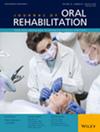Assessment of Cervical Joint Position Sense and Head Posture in Individuals With Myogenic Temporomandibular Dysfunctions and Identifying Related Factors: A Case-Control Study
Abstract
Background
Temporomandibular dysfunctions (TMDs) have the potential to cause changes in cervical muscle strength, muscle endurance and position sense by changing muscle activation patterns, especially as a result of forward head posture. The effects of TMDs on cervical joint position sense (CJPS) and head posture remain controversial.
Objective
The aim of this study was to evaluate the head posture and CJPS of individuals with TMDs and compare them with healthy individuals.
Methods
This research, which was designed as a case-control study, was concluded with the inclusion of total of 84 participants (42 individuals diagnosed with myogenic TMDs, 42 controls). The assessment of participants included pain severity, neck and jaw functionality and disability, CJPS, head posture and temporomandibular joint (TMJ) range of motion (ROM).
Results
Individuals with TMDs exhibited higher angular deviation in CJPS during flexion and extension (p < 0.001). Additionally, individuals with TMDs demonstrated higher TMJ pain, limitation and dysfunction severity, as well as a more limited TMJ ROM (p < 0.001). Head posture was similar between groups (p > 0.05). There is a significant relationship between VAS-TMJ with VAS-cervical, FAI, NDI, JFLS-8 and TMJ ROM (p < 0.05). Moreover, a significant correlation was observed between NDI with FAI and TMJ ROM (p < 0.05).
Conclusion
These results indicate that in addition to higher pain severity, disability and lower jaw ROM, CJPS of individuals with TMDs is also negatively affected. Also, parameters related to disability and functionality of cervical and TMJ were significantly correlated. Further studies are needed to determine the factors contributing to these results.


 求助内容:
求助内容: 应助结果提醒方式:
应助结果提醒方式:


